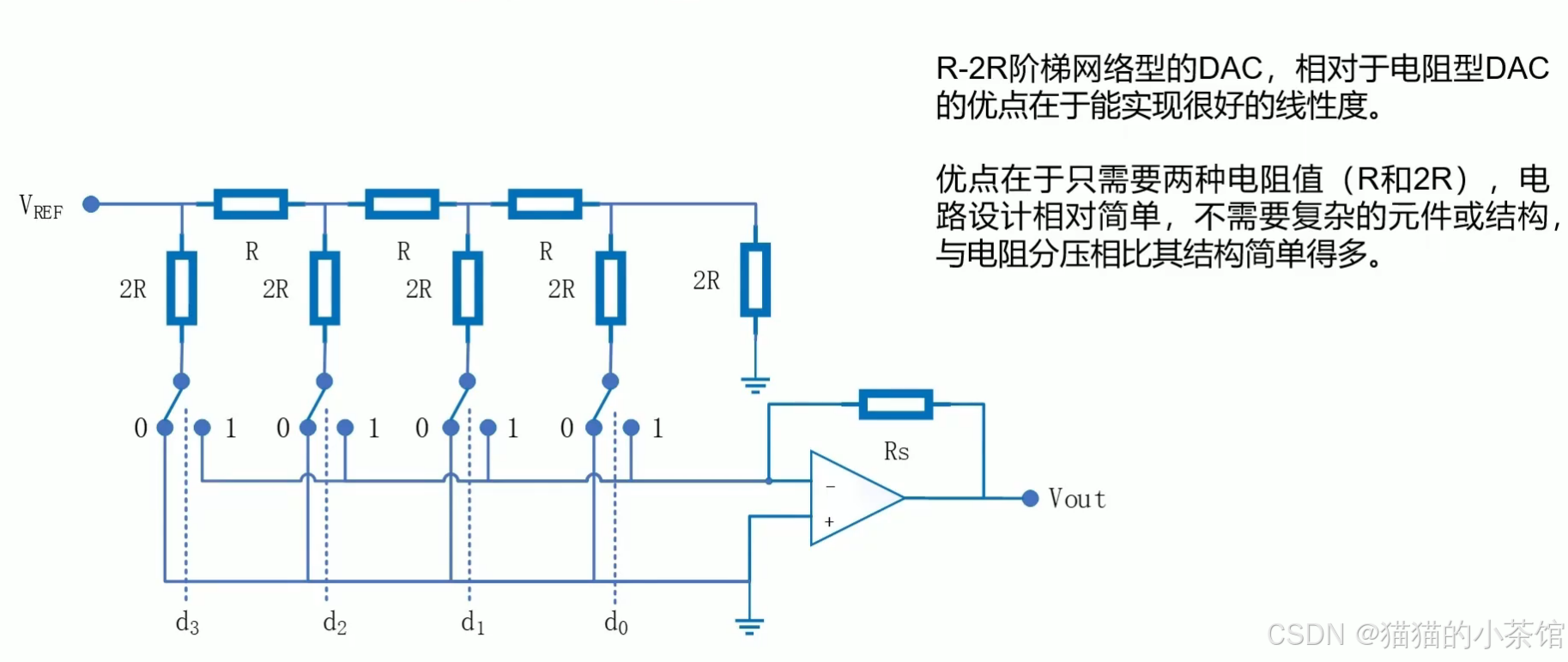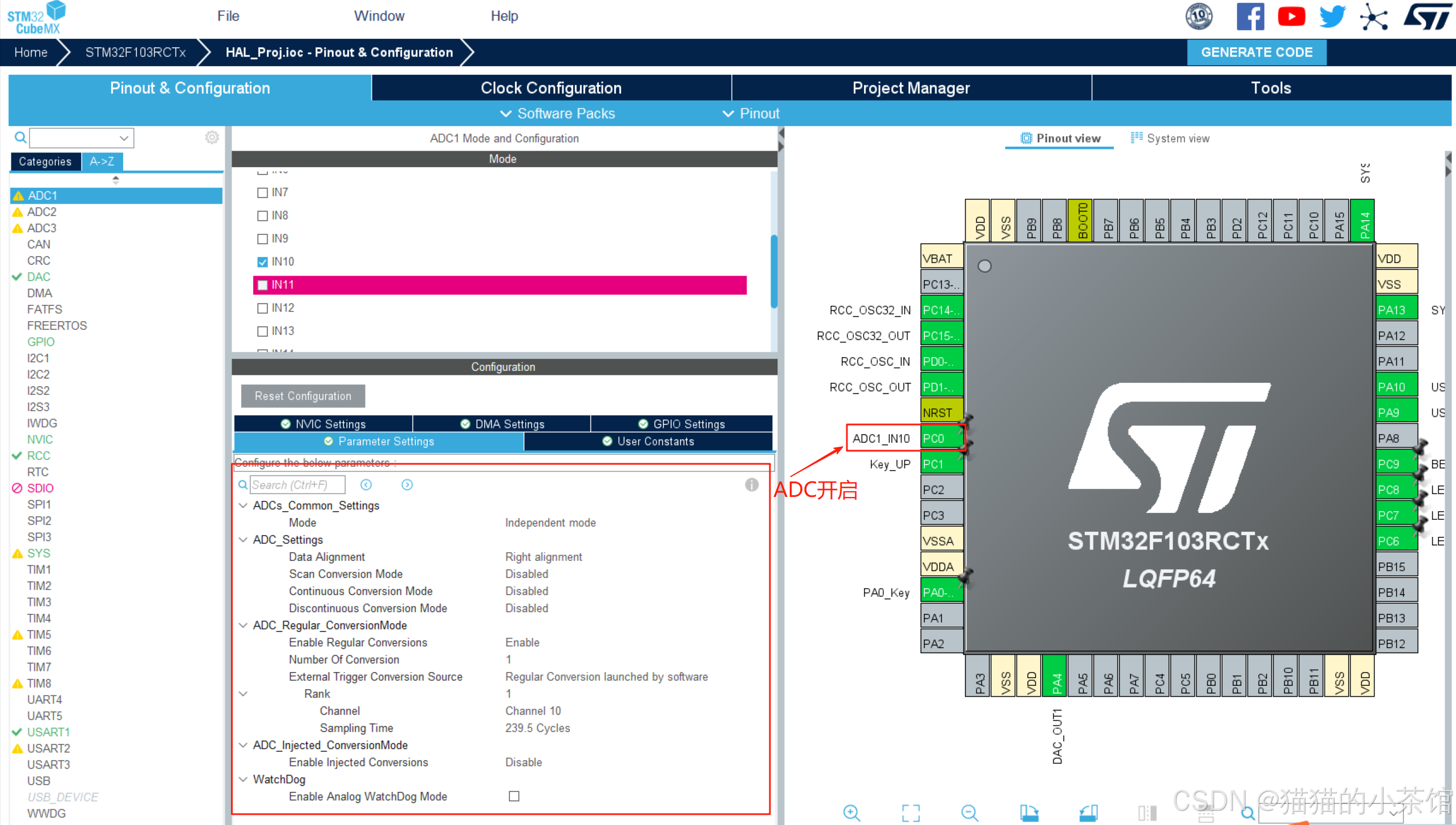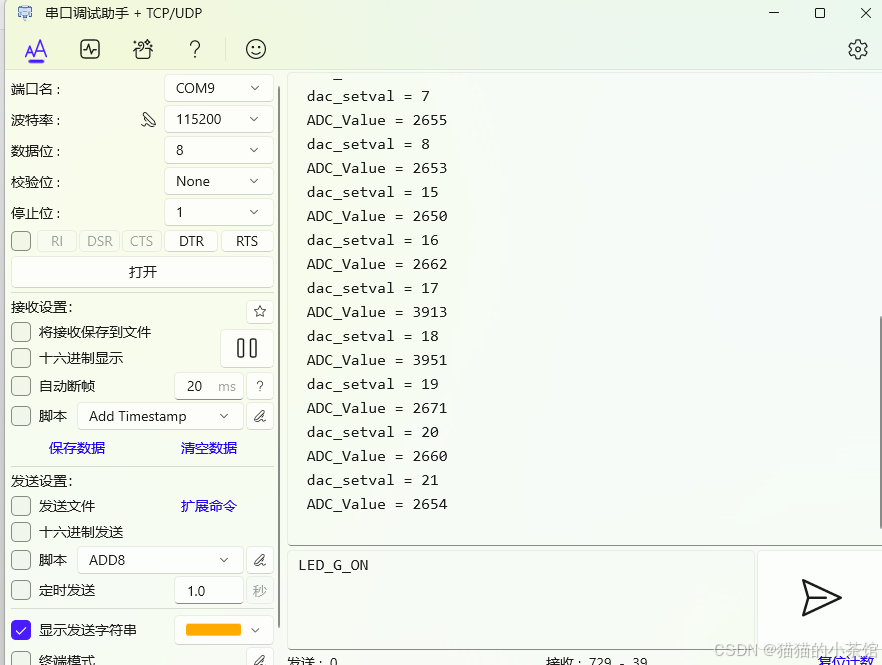DAC 简介
DAC(Digital to Analog Converter):将 MCU 中的数字信号(如 04095)转换为对应的模拟电压输出(03.3V)。
📚 资料推荐
💡 STM32F1 DAC 应用手册(ST 官方)
📘 HAL DAC Waveform Generation 示例
📦 CubeMX 中 DAC + DMA + TIM 正弦波输出示例
🔧 用 STM32 输出音频的 DAC 案例(.wav 文件播放)

STM32 DAC 特性(以 STM32F103 为例)
分辨率:12 位(0~4095)
通道数:2 路(DAC_OUT1、DAC_OUT2)
输出范围:0 ~ VREF(通常是 3.3V)
支持触发方式:软件、定时器、外部中断
可配合DMA 输出连续波形
CubeMX 配置说明
ADC 配置(如下图) :
通道:ADC1_IN10(PC0)
模式:Independent mode
触发方式:软件触发
采样时间设为 239.5 cycles(更稳定)
HAL库中 DAC 的使用流程
| 步骤 | 函数 |
|---|---|
| 1️⃣ 初始化 DAC | MX_DAC_Init() |
| 2️⃣ 启动 DAC 通道 | HAL_DAC_Start() |
| 3️⃣ 设置 DAC 输出值 | HAL_DAC_SetValue() |
| 4️⃣ 可选:DMA 输出波形 | HAL_DAC_Start_DMA() |
| 5️⃣ 可选:定时器控制输出频率 | Trigger = TIMx_TRGO |

DAC 配置(如下图) :
OUT1:启用
Trigger:None(软件触发)
Output Buffer:Disable(默认关闭)
📌 DAC_OUT1 对应引脚:PA4

HAL 代码结构
当前介绍是完成 STM32 中 ADC(模数转换)+ DAC(数模转换) 的双向转换实验。 写代码的时候一定要保证代码结构清晰,CubeMX 配置也要非常规范。我们理解每个知识点务必要遵循:任务目标 ------> 整体结构和原理 ------> CubeMX 配置 ------> HAL 实现 ------> 运行效果 ------> 流程优化 ------> 需求迭代和更新。
✅ DAC 初始化和启动
c
HAL_DAC_Start(&hdac, DAC_CHANNEL_1); // 启用 DAC 通道 1
HAL_DAC_SetValue(&hdac, DAC_CHANNEL_1, DAC_ALIGN_12B_R, 0); // 初始输出为 0
DAC_ALIGN_12B_R:12 位右对齐(最大值 4095)
输出电压计算:
c
Vout = (dac_setval / 4095.0) * VREF✅ DAC 输出值渐变逻辑
输出电压从 0V → 3.3V → 0V 逐渐变化。
每秒更新一次,配合 ADC 采样观察变化曲线。
c
if ((dac_setval < 4095) && (Data_dir == 0)) dac_setval++;
if ((dac_setval > 0) && (Data_dir == 1)) dac_setval--;
if (dac_setval >= 4095) Data_dir = 1;
if (dac_setval == 0) Data_dir = 0;
HAL_DAC_SetValue(&hdac, DAC_CHANNEL_1, DAC_ALIGN_12B_R, dac_setval);实验工作原理
步骤:
① DAC 输出从 0 → 4095(0~3.3V)
② DAC_OUT1(PA4)连接到 ADC_IN10(PC0)
③ ADC 采样电压,转换为数字值
④ UART 串口输出 ADC_Value
⑤ 实时观察 DAC 输出变化对 ADC 的影响
完整代码
📄 main.c
c
/* USER CODE BEGIN Header */
/**
******************************************************************************
* @file : main.c
* @brief : Main program body
******************************************************************************
* @attention
*
* Copyright (c) 2025 STMicroelectronics.
* All rights reserved.
*
* This software is licensed under terms that can be found in the LICENSE file
* in the root directory of this software component.
* If no LICENSE file comes with this software, it is provided AS-IS.
*
******************************************************************************
*/
/* USER CODE END Header */
/* Includes ------------------------------------------------------------------*/
#include "main.h"
#include "adc.h"
#include "dac.h"
#include "usart.h"
#include "gpio.h"
/* Private includes ----------------------------------------------------------*/
/* USER CODE BEGIN Includes */
#include "string.h"
/* USER CODE END Includes */
/* Private typedef -----------------------------------------------------------*/
/* USER CODE BEGIN PTD */
/* USER CODE END PTD */
/* Private define ------------------------------------------------------------*/
/* USER CODE BEGIN PD */
/* USER CODE END PD */
/* Private macro -------------------------------------------------------------*/
/* USER CODE BEGIN PM */
/* USER CODE END PM */
/* Private variables ---------------------------------------------------------*/
/* USER CODE BEGIN PV */
/* USER CODE END PV */
/* Private function prototypes -----------------------------------------------*/
void SystemClock_Config(void);
/* USER CODE BEGIN PFP */
/* USER CODE END PFP */
/* Private user code ---------------------------------------------------------*/
/* USER CODE BEGIN 0 */
uint16_t ADC_Value = 0;
uint16_t dac_setval = 0;
uint8_t Data_dir = 0;
/* USER CODE END 0 */
/**
* @brief The application entry point.
* @retval int
*/
int main(void)
{
/* USER CODE BEGIN 1 */
/* USER CODE END 1 */
/* MCU Configuration--------------------------------------------------------*/
/* Reset of all peripherals, Initializes the Flash interface and the Systick. */
HAL_Init();
/* USER CODE BEGIN Init */
/* USER CODE END Init */
/* Configure the system clock */
SystemClock_Config();
/* USER CODE BEGIN SysInit */
/* USER CODE END SysInit */
/* Initialize all configured peripherals */
MX_GPIO_Init();
MX_USART1_UART_Init();
MX_ADC1_Init();
MX_DAC_Init();
/* USER CODE BEGIN 2 */
HAL_UARTEx_ReceiveToIdle_IT( &huart1 , U1RxData, U1RxDataSize);
HAL_ADCEx_Calibration_Start( &hadc1 ); //开启校准
HAL_DAC_Start( &hdac, DAC_CHANNEL_1); //开启DAC通道 输出使能
HAL_DAC_SetValue( &hdac, DAC_CHANNEL_1 , DAC_ALIGN_12B_R, 0); //设置DAC输出的初始值为 0
/* USER CODE END 2 */
/* Infinite loop */
/* USER CODE BEGIN WHILE */
while (1)
{
if((dac_setval < 4095) && (Data_dir == 0)) dac_setval++;
if((dac_setval > 0) && (Data_dir == 1)) dac_setval--;
if(dac_setval > 4095)
{
dac_setval = 4095;
Data_dir = 1;
}
if(dac_setval <= 0)
{
dac_setval = 0;
Data_dir = 0;
}
printf(" dac_setval = %d \r\n",dac_setval);
HAL_DAC_SetValue( &hdac, DAC_CHANNEL_1 , DAC_ALIGN_12B_R, dac_setval);
HAL_ADC_Start( &hadc1 ); //开启ADC转换
HAL_ADC_PollForConversion( &hadc1, 50); //等待转换完成
if(HAL_IS_BIT_SET( HAL_ADC_GetState( &hadc1 ), HAL_ADC_STATE_REG_EOC) ) //判断是否转换完成
{
ADC_Value = HAL_ADC_GetValue(&hadc1);
printf(" ADC_Value = %d \r\n",ADC_Value);
}
HAL_Delay(1000);
/* USER CODE END WHILE */
/* USER CODE BEGIN 3 */
}
/* USER CODE END 3 */
}
/**
* @brief System Clock Configuration
* @retval None
*/
void SystemClock_Config(void)
{
RCC_OscInitTypeDef RCC_OscInitStruct = {0};
RCC_ClkInitTypeDef RCC_ClkInitStruct = {0};
RCC_PeriphCLKInitTypeDef PeriphClkInit = {0};
/** Initializes the RCC Oscillators according to the specified parameters
* in the RCC_OscInitTypeDef structure.
*/
RCC_OscInitStruct.OscillatorType = RCC_OSCILLATORTYPE_HSE;
RCC_OscInitStruct.HSEState = RCC_HSE_ON;
RCC_OscInitStruct.HSEPredivValue = RCC_HSE_PREDIV_DIV1;
RCC_OscInitStruct.HSIState = RCC_HSI_ON;
RCC_OscInitStruct.PLL.PLLState = RCC_PLL_ON;
RCC_OscInitStruct.PLL.PLLSource = RCC_PLLSOURCE_HSE;
RCC_OscInitStruct.PLL.PLLMUL = RCC_PLL_MUL9;
if (HAL_RCC_OscConfig(&RCC_OscInitStruct) != HAL_OK)
{
Error_Handler();
}
/** Initializes the CPU, AHB and APB buses clocks
*/
RCC_ClkInitStruct.ClockType = RCC_CLOCKTYPE_HCLK|RCC_CLOCKTYPE_SYSCLK
|RCC_CLOCKTYPE_PCLK1|RCC_CLOCKTYPE_PCLK2;
RCC_ClkInitStruct.SYSCLKSource = RCC_SYSCLKSOURCE_PLLCLK;
RCC_ClkInitStruct.AHBCLKDivider = RCC_SYSCLK_DIV1;
RCC_ClkInitStruct.APB1CLKDivider = RCC_HCLK_DIV2;
RCC_ClkInitStruct.APB2CLKDivider = RCC_HCLK_DIV1;
if (HAL_RCC_ClockConfig(&RCC_ClkInitStruct, FLASH_LATENCY_2) != HAL_OK)
{
Error_Handler();
}
PeriphClkInit.PeriphClockSelection = RCC_PERIPHCLK_ADC;
PeriphClkInit.AdcClockSelection = RCC_ADCPCLK2_DIV6;
if (HAL_RCCEx_PeriphCLKConfig(&PeriphClkInit) != HAL_OK)
{
Error_Handler();
}
}
/* USER CODE BEGIN 4 */
/* USER CODE END 4 */
/**
* @brief This function is executed in case of error occurrence.
* @retval None
*/
void Error_Handler(void)
{
/* USER CODE BEGIN Error_Handler_Debug */
/* User can add his own implementation to report the HAL error return state */
__disable_irq();
while (1)
{
}
/* USER CODE END Error_Handler_Debug */
}
#ifdef USE_FULL_ASSERT
/**
* @brief Reports the name of the source file and the source line number
* where the assert_param error has occurred.
* @param file: pointer to the source file name
* @param line: assert_param error line source number
* @retval None
*/
void assert_failed(uint8_t *file, uint32_t line)
{
/* USER CODE BEGIN 6 */
/* User can add his own implementation to report the file name and line number,
ex: printf("Wrong parameters value: file %s on line %d\r\n", file, line) */
/* USER CODE END 6 */
}
#endif /* USE_FULL_ASSERT */测试验证:
验证 DAC+ADC 的结果:

还可以采用其他方法观测结果是否正确:
万用表测 PA4 电压 随 dac_setval 上下变化(0~3.3V)
ADC 采样值与 DAC 输出对应 理论上 ADC_Value ≈ dac_setval(误差几位)
串口观察输出 ADC_Value 随 dac_setval 对称变化
示波器观测 输出电压呈锯齿波形(线性上升下降)以上。 这便是 STM32 中 ADC(模数转换)+ DAC(数模转换) 的双向转换实验 的实现。
以上,欢迎有从事同行业的电子信息工程、互联网通信、嵌入式开发的朋友共同探讨与提问,我可以提供实战演示或模板库。希望内容能够对你产生帮助!